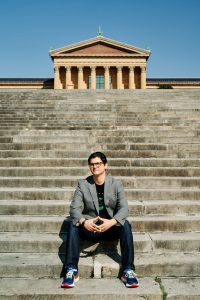
As co-founder and director of Monument Lab, a Philadelphia-based public art and history studio nonprofit, Paul Farber is concerned with memory.
According to Farber, 40, memory can be consecrated in large forms, such as Berlin’s Memorial to the Murdered Jews of Europe, and small forms, such as cookbooks or his childhood handprints and footprints that are stamped on the playground of the Germantown Jewish Centre, the synagogue where he grew up.
Most recently, Farber studied the memorial of one of Philly’s great fictional heroes, Rocky Balboa, as the host of WHYY’s “The Statue.” The six-part podcast wrapped up on Feb. 14.
“To tell the story of Rocky in this city and the Rocky statue is actually to tell the story of a city, of its people, of its immigrants, of the way that history moves, inspires and pushes us,” Farber said.
“That would be an approach to thinking about a monument — not just to look up at it, but to kind of place yourself there and look around and see what you can learn from the perspective of the statue,” he added.
The Rocky statue is, to Farber, the epitome of what makes monuments unique: They do not just represent a person and ask an audience to explore what makes this person worthy of public memory; monuments also contain the history and stories of those who interact with them.
Farber is just one of many Philadelphians with loose ties to the statue and the man it represents. His great-great-grandmother and great-grandparents immigrated to the U.S. and became naturalized citizens at the Washington Avenue Immigration Station. Like many Jewish immigrants, the family operated a pushcart and then a small store. Farber’s grandfather attended South Philadelphia High School and became a member of the boxing club there.
Farber’s family’s roots in Philadelphia are what made him interested in exploring memory in the first place. He often heard stories from his mother about visiting his family’s store. A photo of the Washington Avenue Immigration Station hangs on Farber’s wall.
“Memory lives in our family histories because it’s not often in monument form,” he said. “It’s often our customs and our books and our photo albums and our recipes. And there’s a way in which those who have come before us are kept — their spirit is kept alive — in really meaningful ways.”
With the preservation of memories comes with it the knowledge that memories are also lost and forgotten, through trauma or assimilation.
“What could we know that was brought forward with us? But also how do you deal with very real gaps?” Farber asked.
Born and raised in Mount Airy, where he lives now, Farber grew up in a multifaith community, “where to be Jewish was both about honoring tradition and pushing to build bridges,” a foundation that shaped his upbringing and path.
Farber attended Quaker school and later worked with Baptist ministers. After receiving a bachelor’s degree in urban studies at the University of Pennsylvania, Farber left his hometown to get a master’s degree and doctorate in American culture from the University of Michigan.
His dissertation took him to Berlin to study how American writers and artists documented the Berlin Wall. The paper, and later a book, “A Wall of Our Own: An American History of the Berlin Wall,” was inspired by a Jewish photographer who, in 1961, took pictures of an African American soldier guarding the wall, capturing the complexities of America’s role in protecting global democracy while also grappling with its own racism.
The research made Farber curious about how Jewish history was honored and preserved for other visitors of Berlin, Jewish or not.
“How do we honor the past and make room for ways that we persist into the future?” Farber said. “I’m constantly interested in the ways that people make memories in big and small ways, in ways that are official and unofficial.”
Farber returned to Philadelphia and founded Monument Lab in 2012 with Ken Lum as a series of classroom conversations at Penn that evolved into a nonprofit.
Today, Monument Lab uses its definition of monuments as “statements of power and presence in public” to look at the implications and meanings of monuments around the country and internationally. This spring, Monument Lab will launch another podcast series called “Plot of Land,” exploring how land ownership and housing has changed in the U.S. as a result of public memory and racist policies.
“Not just in Jewish culture, but kind of across boundaries, is the idea that the past, present and future are not so separated,” Farber said. “There’s not a linear history … We carry forward with us traces of the past, and we’re constantly renewing and reimagining it.”



